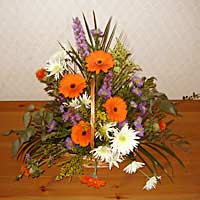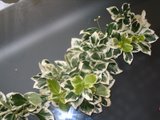Using Foliage in a Floral Bouquet

There used to be a time when foliage was used simply to fill in the gaps! But these days foliage is far more than just a filler. Much of it is beautifully rich looking and can look absolutely spectacular just by itself in a simple arrangement.
 The majority on the market is generally varying shades of green – although some varieties such a leucadendhron or cornus are beautiful reds, oranges and yellows. The use of bare twigs and branches are also becoming increasingly popular – willow placed simply in a tall glass vase can look stunning on its own.
The majority on the market is generally varying shades of green – although some varieties such a leucadendhron or cornus are beautiful reds, oranges and yellows. The use of bare twigs and branches are also becoming increasingly popular – willow placed simply in a tall glass vase can look stunning on its own.
![]()
 But whenever using foliage you must always keep in mind the shape of the flowers you are using, the design you’re after and the effect you are after. Do you want tall and linear or small and compact? Do you want movement in your design or for it to be more structured? These are things that you must always ask yourself because certain types of foliage will not go with certain types of design.
But whenever using foliage you must always keep in mind the shape of the flowers you are using, the design you’re after and the effect you are after. Do you want tall and linear or small and compact? Do you want movement in your design or for it to be more structured? These are things that you must always ask yourself because certain types of foliage will not go with certain types of design.
Medium and small designs work well with ivy, ruscus, choisya, euonymous and hebe, while larger arrangements dictate longer stemmed or wider foliage such as laurel, fatsia leaves; large ferns or cornus.
![]() Whatever your design if you always keep in mind the three Fs you can’t go wrong with your use of foliage. Arrange your foliage, add the filler then highlight with the focal flowers.
Whatever your design if you always keep in mind the three Fs you can’t go wrong with your use of foliage. Arrange your foliage, add the filler then highlight with the focal flowers.
Popular Types of Foliage
- Grasses – bear, steel etc. Beautifully linear and suitable for all sorts of arrangements. You can leave it to “float” or loop it.
- Eucalyptus – an old favourite with florists. Wonderfully scented. Some eucalyptus is sturdy with rigid silvery green leaves, while others are far softer with dark green leaves.
- Hypericum – these berries are perfect for adding a touch of colour to a design. There are several varieties with berries ranging for orange to a beautiful burnt brown red. Also known as St John’s Wort!
- Leucadendron – comes in red, yellow and bronze. The red variety is sometimes known as sunset safari. Tall foliage with sturdy stem.
- Pittosporuim – very popular and can generally be found in most gardens. The green and yellow leaves are small with crinkled edges. This is very long lasting foliage with woody stem.
- Ferns – these make a lovely collar around bouquets. A number of varieties which all add movement to a design.
- Ruscus – this is either soft or hard. Soft ruscus is very floaty and often used in wedding bouquets. Hard ruscus is a staple in many gift bouquets. Both long stemmed.
Looking After Your Foliage
Just like flowers, foliage needs to be cared for to ensure it stays in good condition for a long time. If you can get hold of it, always use mature foliage as both leaves and stems are more robust.
- Once you’ve bought your foliage, re-cut the base of the stems (about an inch) and bunch out to allow air to breathe through the stems
- Allow the foliage to stand loosely in a shallow bucket of water
- Always store your foliage in clean water in a clean container. A few drops of bleach to the water can keep your material clean
- Remove any leaves below the water level
- Avoid placing in direct sunlight, next to a radiator on in draughts
- Keep water topped up regularly before you use it.
- Qualifications Needed to be a Florist
- Ikebana: Traditional Japanese Flower Arranging
- How to Make Wax Flowers
- How to Dry Fresh Flowers
- Floral Skills: Wiring and Taping
- Gift Wrapping a Floral Display and Creating a Florist Bow
- Working With Dried and Fabric Flowers
- Using Floral Foam
- Basic Equipment for Floristry


Re: Using Floral Foam
Hi im making wreaths and centre pieces using wet foam...my problem is that the foam still drips when I've done my arrangement...is it best to…
Re: Create Longer Lasting Floral Displays
Hi All! Do Alstroemerias last in an oasis arrangement? Please advise. Many thanks and sunny greetings Kris
Re: Create Longer Lasting Floral Displays
Hi I am doing an underwater display with silk red roses covering all roses with the water adding wax chystals on the…
Re: Create Longer Lasting Floral Displays
How many chrysants do I need for a DAD tribute when purchasing 20 stems per bunch. Thanks Treez
Re: Create Longer Lasting Floral Displays
I was wondering if I could make my arrangement with floral foam self watering by adding cotton string to a reservoir…
Re: Create Longer Lasting Floral Displays
Hi I am making son and brother funeral flowers using chrysanthemums the funeral is on a Friday will it be OK to make…
Re: Create Longer Lasting Floral Displays
I have heard that England was going to bane oasis and had a new black oasis that was more environment safe. Do you…
Re: Create Longer Lasting Floral Displays
I heard there is new oasis that's black and better for the environment. Can't seem to find it. Can you help?
Re: Creating a Victorian Posy
Hi, carrying out a little research, on Posies, due to the book I am writing concerning a Victorian Gent of the 1800's. Yes he had…
Re: Create Longer Lasting Floral Displays
Hi i haven’t done any funeral wreaths before, but wanted to do the DAD letters, as my dads just died. I have watched…